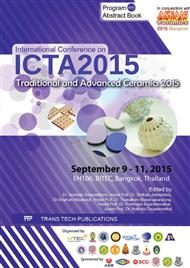p.240
p.246
p.252
p.259
p.264
p.268
p.272
p.276
p.282
Effect of Porosity and Pore Size on Microstructures and Mechanical Properties of Metakaolin Blended with Ca(OH)2 and PLA as Porous Geopolymers
Abstract:
Geopolymer is generally made of pozzolanic materials and alkali activators such as sodium alkali or potassium alkali. It can be solidified at ambient temperature to be developed as construction materials. Polylactic acid (PLA) was chosen to create pores in order for porous geopolymers. In this research, the porous geopolymer was developed either to reduce the weight of materials or to be utilized as thermal insulation materials. It was performed by metakaolin (MK), calcium hydroxide (Ca(OH)2), 10 molar potassium hydroxide (10M KOH) and potassium silicate (K2SiO3) for geopolymer pastes. These geopolymer pastes were mixed with 40 wt%, 50 wt% and 60 wt% of PLA and fired at 550°C for 6 h., therefore, pores inside geopolymer structure were found. Consequently, those geopolymers were characterized the mechanical properties e.g. compressive and flexural strength by Universal Testing Machine (UTM), microstructures by Scanning Electron Microscope (SEM), chemical compositions as functional groups by Fourier Infrared Spectroscope (FTIR). Furthermore, the pore size, bulk density, apparent porosity and thermal conductivity coefficient of geopolymers were analyzed. The results presented that the quantity of PLA affected the compressive strength and porosity of geopolymers. In conclusion, our porous geopolymer with 40 wt% PLA gave the highest strength.
Info:
Periodical:
Pages:
276-281
Citation:
Online since:
May 2016
Price:
Сopyright:
© 2016 Trans Tech Publications Ltd. All Rights Reserved
Share:
Citation:


